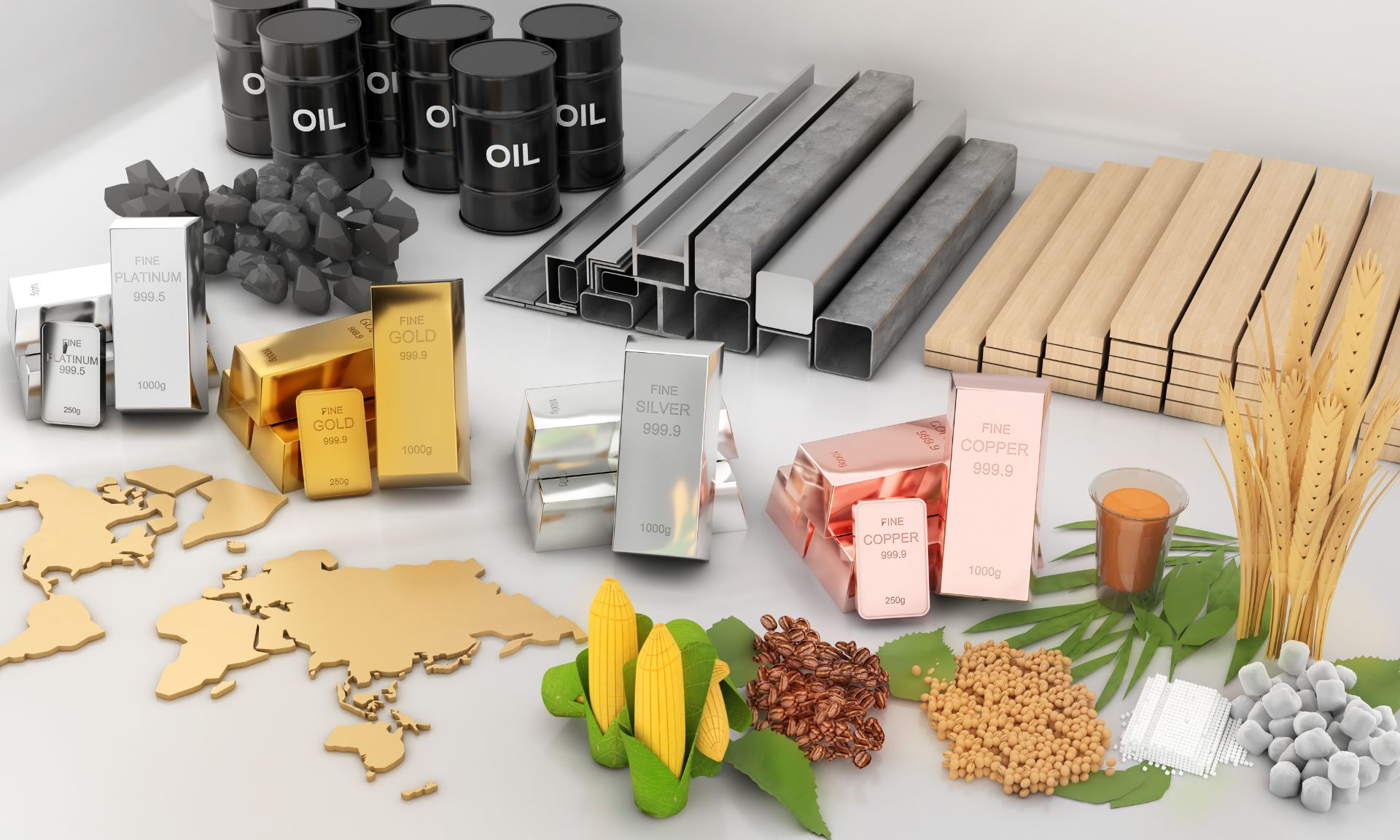Commodities are raw materials and basic goods used in commerce, from agricultural products to precious metals. Their prices fluctuate with global supply and demand, offering investors opportunities to profit. This guide examines the major commodity categories, their unique characteristics, top performers, and effective trading strategies for 2024.
What are Commodities?

A commodity is a basic good used in commerce that is interchangeable with other goods of the same type. The key categories are:
- Metals – Gold, silver, copper, nickel, zinc
- Energy – Crude oil, natural gas, gasoline, diesel, coal
- Grains & Softs – Wheat, corn, coffee, sugar, cocoa
- Livestock – Live cattle, lean hogs, feeder cattle
Commodities can be traded directly by purchasing the physical goods. But they are more commonly traded through futures contracts and other derivatives that track commodity prices.
Why Invest in Commodities?
There are four key reasons investors allocate part of their portfolio to commodities:
Inflation hedge – Commodity prices often rise faster than inflation, protecting investors when the value of cash declines.
Diversification – Commodity prices generally have low correlation to stocks and bonds, making them an excellent portfolio diversifier.
Growth potential – Rapidly growing emerging markets are demanding more commodities, driving up prices.
Profit opportunities – Volatile commodity markets allow experienced traders to generate returns from price swings.
Most Profitable Commodities
Commodity returns vary greatly year-to-year with global economic conditions. But over the past decade, the top performers have consistently been:
Lithium – Up over 750% in 5 years with soaring demand for electric vehicle batteries.
Gold – The safe haven metal has climbed almost 60% in 10 years amid market uncertainty.
Lean hogs – Volatile livestock prices swing with supply and export demand from China.
Understanding what drives individual commodity market trends allows investors to target the most profitable assets.
How to Invest in Commodities
While buying physical commodities like gold bullion is an option, most commodity trading occurs through derivatives and commodity stocks/funds.
Commodity ETFs
Exchange-traded funds (ETFs) provide instant diversified access to commodities. Many track popular benchmarks like the Bloomberg Commodity Index. Examples include:
These let investors gain exposure without trading futures contracts directly.
Commodity Mutual Funds
Actively managed mutual funds focused on commodities aim to outperform benchmarks by tactically trading commodity futures. Higher fees than ETFs, but potential for market-beating returns from experienced managers.
Commodity Stocks
Owning shares of commodity producers offers indirect exposure. For example, ConocoPhillips (COP) stock price rises and falls with oil & gas prices. Rio Tinto (RIO) shares track iron ore and base metals.
Futures Trading
Experienced traders can directly speculate on commodity price moves via leverage futures contracts on exchanges like the CME and ICE. But this carries significant risk if prices move against your position.
Trading Strategies for Beginners
Those new to commodity markets should utilize prudent tactics:
Diversify across agriculture, metals and energy to balance volatility.
Start small to control risk – commodity prices can swing rapidly.
Use stop-losses to contain downside when prices fall.
Research thoroughly – understand what impacts individual markets.
Conservative allocation to broad-based ETFs combined with selected commodity stocks suits most beginners best.
Investing in Energy Commodities
Energy commodities like crude oil, gasoline and natural gas are indispensable to the functioning of the global economy. Their prices directly impact inflation and interest rates.
What Drives Energy Commodity Prices?
Supply & demand – Global economic growth accelerates energy consumption, while wars and natural disasters constrain output. OPEC policy also attempts to balance oil markets.
Inflation – Higher consumer prices typically reflect increased energy input costs being passed through supply chains out to customers.
US dollar – Most energy commodities are priced in dollars, so a weaker dollar pushes prices higher.
Geopolitics – Conflicts in key producing regions like the Middle East and Russia cause supply concerns that spike prices.
Top Energy Commodity Performers
Brent Crude Oil – The world’s primary benchmark averaged $101/barrel in 2022 after surging on Russia/Ukraine conflict.
RBOB Gasoline – Hit record nominal highs above $4/gallon in 2022 on recovering demand and squeezed refining capacity.
Henry Hub Natural Gas – Surged over 50% to 15-year highs on tight inventories and the gas crisis in Europe during 2022.
How to Trade Energy Commodities
Energy stocks like Exxon Mobil (XOM) and Schlumberger (SLB) offer exposure. Conservative investors can buy energy ETFs such as Energy Select Sector SPDR ETF (XLE). But active futures traders target NYMEX WTI crude, Brent oil, gasoline, heating oil for short-term gains.
Trading Agricultural Commodities
Food commodities are essential to basic human needs, with farmers striving to meet accelerating global protein demand. Prices swing with weather impacts on harvests.
What Impacts Grains & Softs?
Weather – Drought, floods and crop disease influence production volumes and food commodity prices.
Emerging market demand – Rising Asian incomes spur higher meat consumption and feed grain demand.
Biofuels – Corn and soybeans used for ethanol compete with food demand.
Crop reports – Government forecasts from USDA and WASDE move markets around harvests.
Export sales – China drives soybean demand while wheat flows to Africa and the Middle East.
Top Agriculture Commodity Returns
Coffee – Arabica prices soared over 80% to 10-year highs in 2021 amid Brazilian frost damage before retreating in 2022.
Soybean oil – Ukraine conflict and drought propelled over 45% returns in 2022 on tight edible oil supply.
Oats – Up 30% over two years with surging inclusion in healthy breakfast foods and plant-based milks.
Trading Grains, Softs and Livestock
From soybean farmers to coffee shop owners, a vast industry underpins food production. Archer-Daniels-Midland (ADM) and Bunge Limited (BG) connect growers to consumers. Tyson Foods (TSN) and Pilgrim’s Pride (PPC) process livestock. While agriculture stocks offer exposure, active traders target CME and ICE futures across corn, soybeans, wheat, coffee, sugar, lean hogs, live cattle and more.
Investing in Precious Metals
For centuries, gold and silver have stored value as jewelry, currency and inflation hedges. Scarcity underpins their enduring worth.
What Moves Precious Metal Prices?
Inflation/deflation – Gold typically rises when purchasing power of currencies declines.
Currency moves – Weaker dollar boosts dollar-priced gold, silver attractiveness to foreign buyers.
Geopolitical crises – Conflict flashes spur safe haven demand, lifting prices.
Jewelry/investment demand – Gold and silver have cultural significance in emerging economies.
Central bank policies – Holdings of gold reserves supports prices.
Mining industry economics – Production costs and new mine output impact long-term pricing.
Top Precious Metal Returns
Gold – After hitting record highs above $2,000/oz in mid-2020, prices remain elevated on high inflation.
Silver – Volatile “poor man’s gold” tends to outperform gold in bull markets due to higher industrial usage.
Platinum – The overlooked precious metal used in catalytic converters boasts bargain valuation today.
Investing in Gold, Silver & Platinum
From gold miners like Barrick Gold (GOLD) and streaming/royalty firms such as Franco-Nevada (FNV), producers offer leverage. For direct ownership, Sprott Physical Gold Trust (PHYS) and iShares Silver Trust (SLV) give bar backing. Futures traders need nerves of steel to trade gold, silver, platinum and palladium contracts.
Investing in Industrial Metals & Minerals
Modern infrastructure depends on base metals like copper and iron ore. Population growth plus rapid urbanization in emerging economies drives commodity demand. Lithium and cobalt enable clean energy.
What Impacts Industrial Commodity Prices?
Manufacturing activity – Metals input costs directly rise and fall with economic growth and factory production.
US Dollar – Weaker dollar makes commodities cheaper for foreign buyers, lifting prices.
New technologies – Expanding 5G networks, EVs and battery storage excite “new economy” minerals.
Top Industrial Commodity Returns
Lithium carbonate – Vital for EV batteries, prices skyrocketed 500% in 2021-22 before retreating nearly 70%. Long-term upside remains strong.
Cobalt – A key lithium-ion battery ingredient, cobalt gained almost 50% in 2022 on accelerated demand before falling back.
Iron Ore – Critical for steelmaking, inputs like iron ore outperformed in the pandemic recovery, gaining ~80% off 2020 lows before sliding.
Trading Base Metals & Minerals
Australia, Brazil and Canada dominate materials mining. Leaders like BHP (BHP), Rio Tinto (RIO) and Vale S.A. (VALE) ship ores to China for processing. ETFs such as iShares MSCI Global Metals & Mining Producers ETF (PICK) offer diversified exposure. But active traders again look to futures on the London Metals Exchange and Shanghai Futures Exchange across copper, aluminum, zinc, steel, lithium and more.
To Recap
While commodity returns are historically volatile, their low correlation to stocks and bonds makes them potent portfolio diversifiers. Their intrinsic value and supply scarcity helps insure against both inflationary regimes and financial market declines.
This guide has covered the unique fundamentals driving individual commodity markets along with investing approaches tailored to beginners. Maintaining an allocation alongside stocks, bonds and real estate relies upon continuously tracking the commodity landscape for emerging opportunities.
In another related article, A Comprehensive Guide to Understanding and Investing in Commodities





